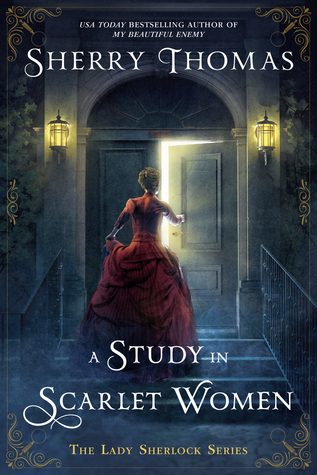 A Study in Scarlet Women (Lady Sherlock, #1) by Sherry Thomas
A Study in Scarlet Women (Lady Sherlock, #1) by Sherry Thomas Formats available: paperback, ebook, audiobook
Series: Lady Sherlock #1
Pages: 336
Published by Berkley on October 18th 2016
Purchasing Info: Author's Website, Publisher's Website, Amazon, Barnes & Noble, Kobo, Bookshop.org
Goodreads
USA Today bestselling author Sherry Thomas turns the story of the renowned Sherlock Holmes upside down… With her inquisitive mind, Charlotte Holmes has never felt comfortable with the demureness expected of the fairer sex in upper class society. But even she never thought that she would become a social pariah, an outcast fending for herself on the mean streets of London. When the city is struck by a trio of unexpected deaths and suspicion falls on her sister and her father, Charlotte is desperate to find the true culprits and clear the family name. She’ll have help from friends new and old—a kind-hearted widow, a police inspector, and a man who has long loved her. But in the end, it will be up to Charlotte, under the assumed name Sherlock Holmes, to challenge society’s expectations and match wits against an unseen mastermind.
My Review:
I love Sherlock Holmes pastiches, so when I saw the eARC of A Study in Scarlet Women, I was instantly intrigued. Sherlock Holmes has been adapted in so many different directions, from the very different modern TV incarnations of Sherlock and Elementary to the slightly off-tangent House to the married Holmes in Laurie R. King’s Mary Russell series along with the fantasy version in the late Randall Garrett’s Lord Darcy series and Neil Gaiman’s award-winning A Study in Emerald.
While there was a well-known series by Carole Nelson Douglas that features Irene Adler (“the woman” from A Scandal in Bohemia) as a Sherlock Holmes-type detective, I’ll admit that I can’t find a citation for an actual female Holmes, although I know I’ve read them.
A Study in Scarlet Women is just that – it posits Sherlock Holmes as a woman who uses Sherlock Holmes as a nom-de-guerre to shroud her work in an air of mystery, and to keep both the police and the criminal element from dismissing her as merely a female. The rendering of Sherlock Holmes, nee Charlotte Holmes, in A Study in Scarlet Women is contemporaneous with the original Sherlock Holmes canon. One of the elements that is both fascinating and frustrating about A Study in Scarlet Women is that Charlotte Holmes does not feel anachronistic to her era at all. She is forced to deal with all of the prejudices and restrictions that surrounded young women of that era, and find a way around them.
While she does get a bit luckier than is probably likely, even her solutions fit within the time-frame. She hides who she really is behind a fictional “brother”, and conducts many of her consultations via the post, the better to hide her physical self.
Part of the frustration in this book is that those restrictions were very, well, restrictive. Charlotte’s solution to the problem of getting out from under her parents’ control while not putting herself under the control of a husband is ingenious. She reckons with all of the consequences to herself, but neglects to factor murder into her calculations. Not that she committed one, nor has anyone in her family, but that her disgrace gives her sister and her parents a reason to commit one, and puts them under suspicion of having done so.
Her first case arises from a need to clear their names, as well as to see justice done.
There is a Watson, and her origins (yes, her) are even more fascinating than Holmes, both in the ways that they do and do not follow the original character. Mrs. Watson, a well-to-do widow, comes to Charlotte’s rescue when she is at her most desperate, and finds a common cause and a new lease on life assisting in Charlotte’s investigations.
Where Dr. John Watson was a veteran of the Afghan war, Mrs. John Watson is the widow of an Army doctor who was killed in, of course, the Afghan War. However, Mrs. Watson, nee Joanna Hamish Redmayne, is also a former actress and retired denizen of the demimondaine, and therefore a scarlet woman. As is Charlotte, who arranged to have herself “ruined” to escape the strictures of upper-middle-class respectable and restricted womanhood.
It is these two scarlet women, with the help of Charlotte’s somewhat reluctant childhood friend, and an even more desperate police detective, who discover the link between a series of seemingly unrelated murders, and get Charlotte’s family off-the-hook.
It is the beginning of what I hope will be a brilliant career for Charlotte, make that Sherlock, Holmes.
Escape Rating B+: As I said at the beginning, this story is both fun and frustrating, sometimes in equal measure. Because it posits a female Sherlock Holmes during the Victorian Era, the character and the reader are forced to deal with the upper-class-Victorian restrictions on women’s, particularly young women’s, lives and movements. The first third of the book has to feature Charlotte’s solution to this particular quagmire, and its immediate consequences. It’s a situation that shows Charlotte’s resolution and self-knowledge, but for 21st century readers it’s fairly ugly. It feels realistic, but no fun at all to read through.
And we need to see the consequences of Charlotte’s tough decisions and all of their unfortunate direct consequences for Charlotte until she very nearly hits rock-bottom. It’s only at that point that she is rescued by the equally unconventional Mrs. Watson, and her story really begins.
Because Watson in this case is older and has more experience of the world, Holmes and Watson are much more nearly equal than some of the popular misconceptions about the pair. This Watson is no dunderhead. She is not the genius that Holmes is, but her acting ability, knowledge of the social strata and ability to understand people makes her a partner rather than a mere sidekick. Especially since Mrs. Watson provides the initial funds for the entire enterprise!
As the story unfolds, the reader gets to play a game of “spot the character” as we determine who in this new version is playing the parts that are familiar from the original canon. For example, the author of the stories will not be Watson, but Charlotte’s sister. It’s a fun game and I enjoyed figuring out who was who.
The case was every bit as convoluted, and the solution every bit as difficult, as any of the original Holmes’ cases. The clues may be there from the beginning, but determining whodunnit and why is an effort that takes both Charlotte and the reader the entire story.
One part of A Study in Scarlet Women troubles me just a bit. As is famously known, the original Sherlock Holmes seems to have had no truck with emotion of any kind. Until the version of Holmes portrayed in the Mary Russell stories, Holmes and romance have seemed to be, not merely on different continents, but on far distant planets from one another.
There is not exactly a romance in A Study in Scarlet Women, but there’s not exactly not one either. Charlotte’s childhood friend, Lord Ingram Ashburton, is clearly the man she should have married. And very much vice-versa. But they didn’t realize it until much too late, after Ingram was not only married but had discovered that his wife had only married him for his money and title. It is not a happy marriage, or even a companionable one. But Ingram is an honorable man, perhaps to a fault. The amount of unresolved sexual tension between Ingram and Charlotte is enough to light London for a month through a pea-souper fog. I wonder how this conundrum will get resolved as the series continued.
I wonder even more why it was necessary to introduce a romantic element for Holmes in the first place. Hopefully we’ll see in future entries in the series.





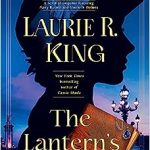
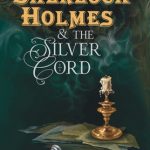





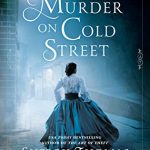
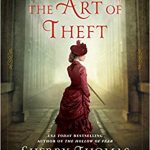








One thought on “Review: A Study in Scarlet Women by Sherry Thomas”
Comments are closed.